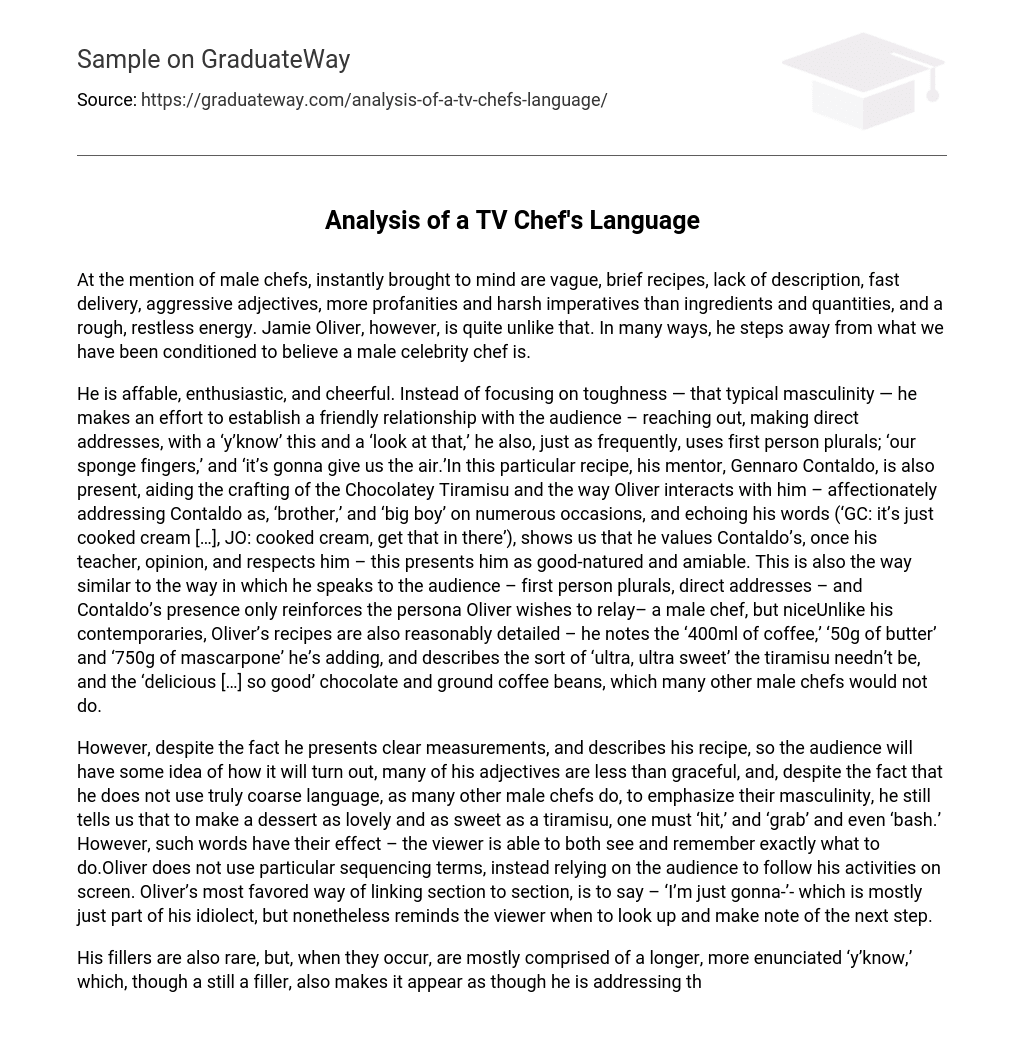When thinking of male chefs, the first thing that usually comes to mind is an image of vague and brief recipes, a lack of descriptions, fast delivery, aggressive adjectives, a tendency towards more profanities and harsh imperatives rather than providing clear instructions on ingredients and quantities, and an overall rough and restless energy. However, Jamie Oliver breaks away from these stereotypes and defies what we have been conditioned to expect from a male celebrity chef.
He is friendly, enthusiastic, and cheerful. Instead of focusing on toughness, he makes an effort to establish a friendly relationship with the audience. He reaches out and makes direct addresses, using phrases like ‘y’know’ and ‘look at that.’ He also frequently uses first person plurals, such as ‘our sponge fingers’ and ‘it’s gonna give us the air.’ In this particular recipe, his mentor Gennaro Contaldo is also present, aiding in the crafting of the Chocolatey Tiramisu. The way Oliver interacts with Contaldo shows that he values his opinion and respects him. He affectionately addresses Contaldo as ‘brother’ and ‘big boy,’ echoing his words. This presents Oliver as good-natured and amiable. Oliver speaks to the audience in a similar way, using first person plurals and direct addresses. Contaldo’s presence reinforces the persona Oliver wishes to relay – a male chef, but nice. Unlike his contemporaries, Oliver’s recipes are reasonably detailed. He notes the amounts of coffee, butter, and mascarpone he’s using. He describes the level of sweetness the tiramisu needn’t be and the delicious chocolate and ground coffee beans. Many other male chefs would not provide such details.
Although he provides clear measurements and describes his recipe, Jamie Oliver’s choice of adjectives is not very elegant. Unlike many other male chefs who use coarse language to emphasize their masculinity, Oliver still uses words like “hit,” “grab,” and even “bash” to make a dessert as delicious as tiramisu. Despite their less graceful nature, these words are effective in helping the viewer remember exactly what to do. Instead of using specific sequencing terms, Oliver relies on the audience to follow his activities on screen. His preferred way of linking sections is by saying “I’m just gonna-” which is mostly part of his unique way of speaking but also serves as a reminder for the viewer to pay attention to the next step.
His use of fillers is rare, but when they do occur, they mostly consist of a longer, more pronounced ‘y’know.’ This filler, although still a filler, gives the impression that he is directly addressing the audience. As a result, the audience feels more engaged and as if they are personally being taught the recipe. This also adds to the authenticity of the episode, along with his seamless interactions with Contaldo. His naturalness makes him much more likable. Additionally, Oliver’s casual language, using phrases like ‘gonna,’ ‘a bit like,’ and ‘wrecked it,’ not only make him friendly but also familiar. He comes across as an everyday person, someone you would meet anywhere, who also happens to be exceptionally skilled at cooking.
This text highlights the broad appeal of Oliver as a cooking instructor. His friendly and funny persona appeals to a wide audience, including younger individuals interested in learning to cook and experienced individuals seeking simpler recipes. Notably, Oliver’s approach is appealing to both men and women. While some male chefs use restlessness and aggression to engage their audiences, Oliver’s warmth, clear recipes, and genuine enthusiasm make his recipes attractive and manageable for a diverse range of people.
The speaker effectively teaches cooking by providing specific quantities, such as ‘150g of sugar’ and ’50g of butter’, while also allowing for some improvisation with phrases like ‘a little swig’ and ‘a little bit’. This engaging approach encourages the audience, particularly those already familiar with cooking. Additionally, the fast pace and varied tone of the speaker keeps the audience interested and prevents boredom. This teaching style works well for somewhat experienced cooks rather than beginners, as the specific quantities can be exact, but the lack of defined sequencing terms may confuse novices who are not constantly watching the screen. However, the speaker’s friendly persona appeals to a diverse range of viewers, ensuring popularity and making it an effective method to teach cooking.





